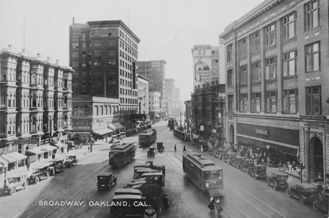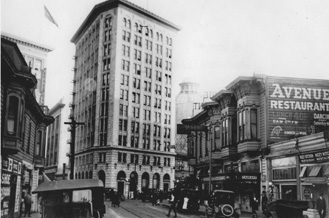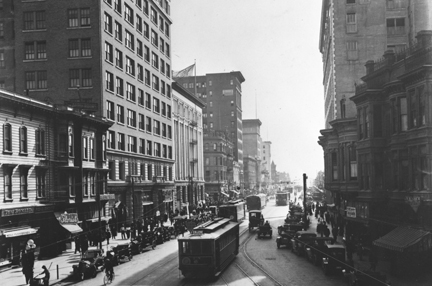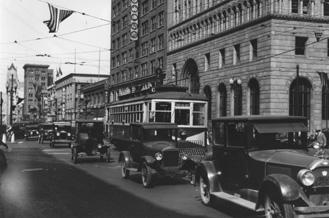
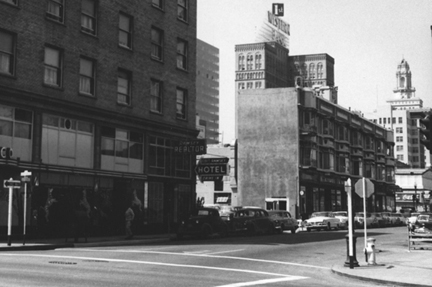
Building permit #96922 was issued on October 7, 1924 for the subject building at a projected cost of $42,330.The owner is shown as Mrs. A.E. White, the builder as R.W. Littlefield, and the architect as C.N. Burrell.The name of the building apparently refers to Mrs. Addie E. White, widow of William H.H. White, although no historical information is available about either husband or wife at this time.
The White Building is the finest example of a characteristic downtown Oakland building type of the 1920’s, which is especially concentrated along 15th and l7th Streets between Franklin and Harrison Streets. The type is characterized by ground floor retail space and upper level loft or office space in small scaled (2 or 3 stories) usually narrow buildings with a maximum of glass area. The type is distinctive of and perhaps unique to downtown Oakland, at least in the number of examples which survive. As a Type, it responds to particular economic and functional requirements: these two streets were opened in the early 192O’s, creating long, narrow, odd-sized Lots-cf. 17th Street Commercial District SHRI. The White Building is elevated above other examples of this type by the use of materials, textures, and colors; the crispness of detail; the articulation of parts and simultaneous coherence of expression; the effective integration of historicist motifs into an unusually modernist building of its period; the fluidity and lightness of its design; and the conscious response of the design to functional requirements within a controlled aesthetic idea. The alternating bands of glass and solid wall surfaces which undulate over the bay windows recall Burnham and Root’s Reliance Building in Chicago of 1889
Architect Clay N. Burrell designed a large number of Oakland Buildings, including the Oaks Hotel at 585-89 15th Street and the Lawrence warehouse at 116-26 Broadway, (see SHRI forms) both of which, like the White Building, use imaginative design treatments.
The White Building is one of a cohesive group of early 20th century low rise commercial structures along 15th Street between Harrison and Franklin Streets (see also SHRI forms for 300-18 15th Street/1501 Harrison Street and 375- 97 15th Street/1440-50 Franklin street Street), and appears individually eligible for the National Register.
DESCRIPTION
Architectural style: Chicago Commercial with Tudor/Jacobean Ornamentation
Briefly describe the present physical description of the site or structure and describe any major alterations from its
original condition:
A long, narrow three-story attached corner office and store building of steel frame
construction with reinforced concrete floors and curtain walls. The facades are
in a two part vertical composition with a first floor commercial base, a two story
upper zone, and stylized Tudor/Jacobean ornamentation. The upper zone is surfaced
with yellow-brown pressed brick and painted cement plaster.
The 15th Street side is divided into seven bays separated on the first floor by slender cast iron fluted Corinthian pilasters with plaster colonette on the two story upper zone. The generally unaltered ground floor contains the upper floor entry in the center bay and two storefronts in each of the side bays. The paired storefront entries are recessed in the center of the bays and consist of Tudor-arched single pane’ glazed wood doors below single-paned transoms. The entries are flanked by large, single-pane show windows. A brick framed clerestory consisting of two long, vertically separated lights and squarish end lights extends across the top of each storefront bay. The upper floor entry is open to the street and recessed within an elongated Tudor-arched opening that penetrates the clerestory panel above. The entry is flanked by show windows, with the stairway to the upper floors behind the left window; a separate small store space is behind the right window. A plaster panel in the clerestory area above the entry reads “WHITE BLDG” in raised lettering.
The upper floors have two continuous bands of single-paned fixed and casement windows layered between the first floor clerestory panels, a band of spandrels between the second and third floors and a top parapet band which masks a slightly sloped roof. The window bands and the spandrel band undulate over polygonal bay windows occupying the center of each bay. The end bay windows extend upward to include the parapet band. The second floor bay windows have transoms and butted glass joints at the bay corners emphasizing the continuity of the glass surfaces; the third floor windows are Tudor-arched. The spandrel band between the second and third floor is brick, with plaster panels on the bay windows. A thin plaster band decorated with bosses runs along the top of the third floor windows below the much wider parapet band, which is brick with horizontal plaster panels in the center bays and scored plaster in imitation of stone on the projecting bay window sections of the end bays; each of the projecting sections has a central crenel splitting the top of its front face. Galvanized iron coping lines the top of the parapet between spiraled galvanized iron spindle finials that cap the colonettes dividing the bays. The narrow Webster Street facade has a single bay treated the same as the 15th Street end bays. Like the first floor, the second and third floors appear essentially unaltered.
Downtown Oakland in the ‘60s
